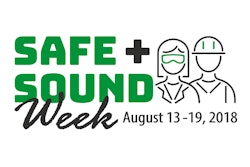
The U.S. Department of Labor’s Occupational Safety and Health Administration (OSHA) aims to support workplace safety and health programs during Safe + Sound Week, which was recognized Aug. 12-18 2019.
Organizations nationwide recognized the importance and success stories of their company’s safety programs during the week-long event. The week is dedicated to highlight workers’ innovative contributions to improving safety and to encourage employers to implement workplace safety initiatives.
However, the week-long event is designed to spur a year-round safety culture at construction companies across the country.
Each week, employers pay an estimated $1 billion for direct workers’ compensation costs alone. OSHA says that businesses that incorporate safety and health programs can prevent injury and illness and improve productivity while reducing impacts to the bottom line.
Successful safety and health programs can proactively identify and manage workplace hazards before they cause injury or illness, improving sustainability and the bottom line. Participating in Safe + Sound Week can help get your program started, energize an existing one, or provide a chance to recognize your safety successes.
For companies who may not be ready to implement a complete safety and health program, here are some simple steps from OSHA you can take to get started. Completing these steps will give you a solid base from which to take on some of the more structured actions you may want to include in your program.
1. Establish safety and health as a core value.
Tell your workers that making sure they finish the day and go home safely is the way you do business. Assure them that you will work with them to find and fix any hazards that could injure them or make them sick.
2. Lead by example.
Practice safe behaviors yourself and make safety part of your daily conversations with workers.
3. Implement a reporting system.
Develop and communicate a simple procedure for workers to report any injuries, illnesses, incidents (including near misses/close calls), hazards, or safety and health concerns without fear of retaliation. Include an option for reporting hazards or concerns anonymously.
4. Provide training.
Train workers on how to identify and control hazards in the workplace, as well as report injuries, illnesses and near misses.
5. Conduct inspections.
Inspect the workplace with workers and ask them to identify any activity, piece of equipment, or materials that concern them. Use checklists to help identify problems.
6. Collect hazard control ideas.
Ask workers for ideas on improvements and follow up on their suggestions. Provide them time during work hours, if necessary, to research solutions.
Survey Reveals Contractors' Top Safety Concerns for 2019
7. Implement hazard controls.
Assign workers the task of choosing, implementing, and evaluating the solutions they come up with.
8. Address emergencies.
Identify foreseeable emergency scenarios and develop instructions on what to do in each case. Meet to discuss these procedures and post them in a visible location in the workplace.
9. Seek input on workplace changes.
Before making significant changes to the workplace, work organization, equipment, or materials, consult with workers to identify potential safety or health issues.
10. Make improvements to the program.
Set aside a regular time to discuss safety and health issues, with the goal of identifying ways to improve the program.
Learn more: Five Safety Awareness Tips for the Asphalt Industry
Top Four Construction Health Hazards & What to Do About Them
Essential Safety Equipment Road Workers Need for Night Work




















